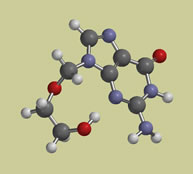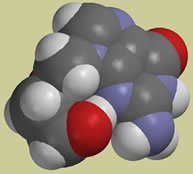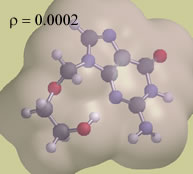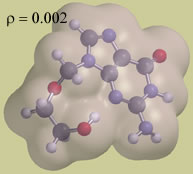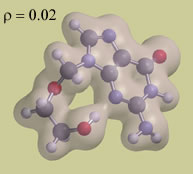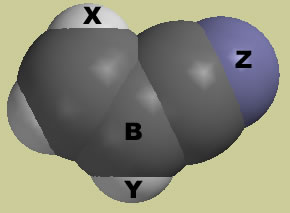
|

|
Molecular
size and electron density
There are many situations where it is useful to be able to mark a molecule's boundary, and use the marked boundary to get information about molecular size and shape. Space-filling models have traditionally been used to mark molecular boundaries. More recently, chemists have begun using electron density data to mark boundaries. The latter approach is more appealing, perhaps, because the resulting boundary is uniquely tailored to each molecule and does not rely on questionable assumptions about atom shape.
Space-filling models Space-filling models are based on the idea that each type of atom has a well-defined size or radius. This radius is called the atom's nonbonded radius (or van der Waals radius) because it reflects the minimum amount of room the atom tries to maintain around itself in order to avoid other nearby atoms. The assumption that atoms have well-defined radii is rather crude. Radii depend on the method of measurement. Atoms in the gas phase typically have different radii from atoms in liquids or solids. Also, an atom's radius depends on its surroundings. Despite these caveats, chemists have developed a standard set of radii and use them to build space-filling molecular models. These models are constructed by placing a sphere at each atom's position, and setting the sphere's radius equal to the atom's nonbonded radius. The resulting cluster of spheres is a convenient marker of molecular boundaries, and can also be used to estimate molecular volumes and surface areas. A space-filling model of the antiviral medication, acyclovir, is shown below (right). A standard ball-and-spoke model is provided for comparison (left).
The two models are displayed on exactly the same scale. It's rather striking how much room atoms need! All of the "empty space" that seems to be present between atoms, and inside rings, in the ball-and-spoke model vanishes when we look at a space-filling model. If you look carefully at the space-filling model, you will also see that no atom appears as a complete sphere (click on the model for a larger image). If an atom appeared as a complete sphere, it would mean the atom was not bonded to anything else. Atoms approach each other very closely when they form a covalent bond and their spheres overlap strongly (in fact, this is an unmistakable and reliable sign of bonding whenever you look at a space-filling model). All of the atoms in acyclovir are bonded to at least one other atom, so all of the spheres overlap.
SIZE isodensity surface Space-filling models are easy to make, but they have two drawbacks: they rely on standard radii and they assume every atom is spherical. These are questionable assumptions, but the resulting errors are usually overlooked. One way to avoid these errors is to use electron density to mark molecular boundaries. The following pictures show three different isodensity surfaces of acyclovir along with a space-filling model. Boxes have been drawn around each picture to help you compare boundary positions.
It should be evident that the 0.02 (bottom) and 0.0002 (top) isodensity surfaces are too close and too far from the nuclei, respectively, to be used as "space-filling models." The 0.002 isodensity surface, on the other hand, is very similar to the space-filling model in shape and size. We will use the 0.002 isodensity surface throughout this course as a quasi-molecular boundary. (The surface cannot be a true boundary because there is still some electron density outside of it.) We will also give this surface a special name and refer to it as a molecule's SIZE isodensity surface (or SIZE surface for short).
What factors dictate atom size? (Optional reading) under construction
Review problems
Questions #1-3 refer to the space-filling model shown above. #1. Assuming H = white, C = gray, and N = blue, what is this molecule's molecular formula?
#2. Which of the labeled atom(s) are bonded to atom B?
#3. This molecule is neutral. Draw its Lewis structure.
#4. Decide whether each statement is TRUE or FALSE.
|
